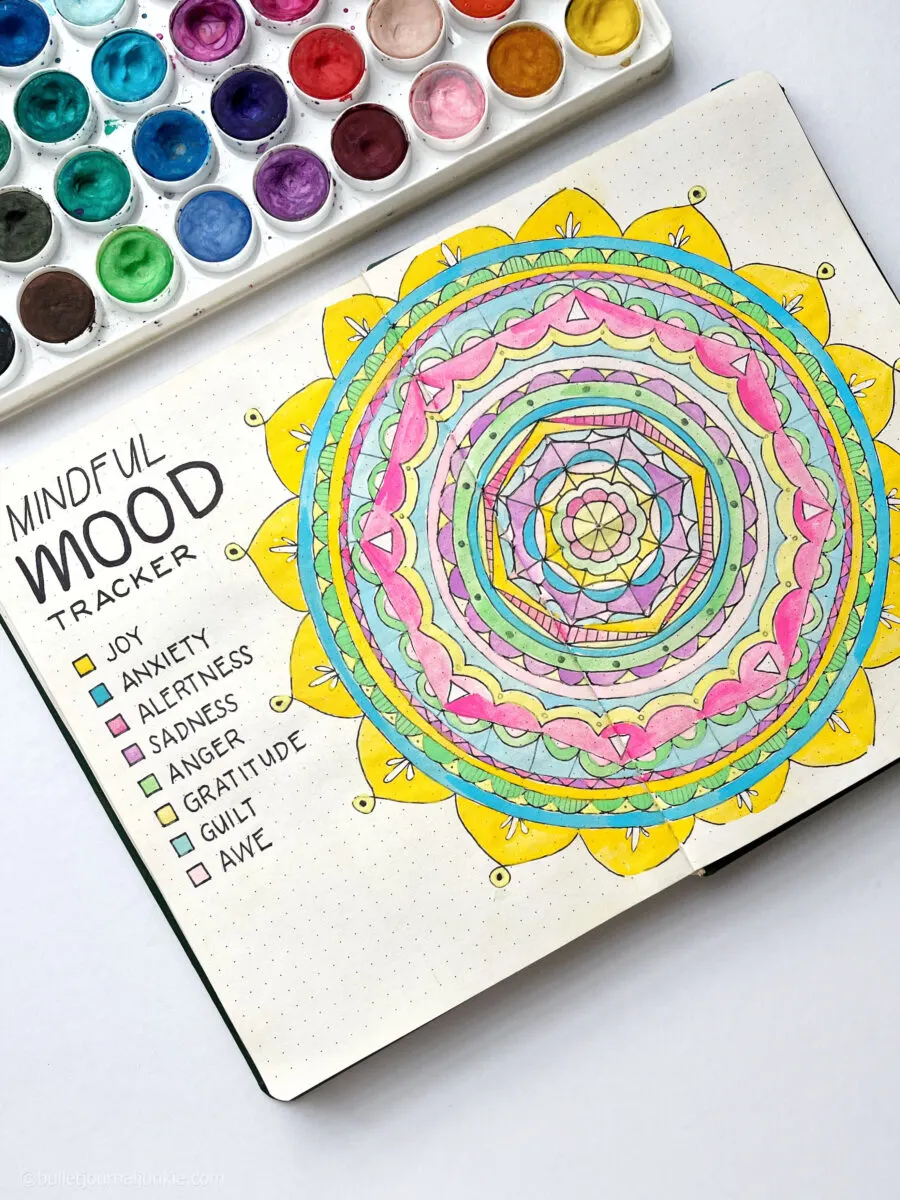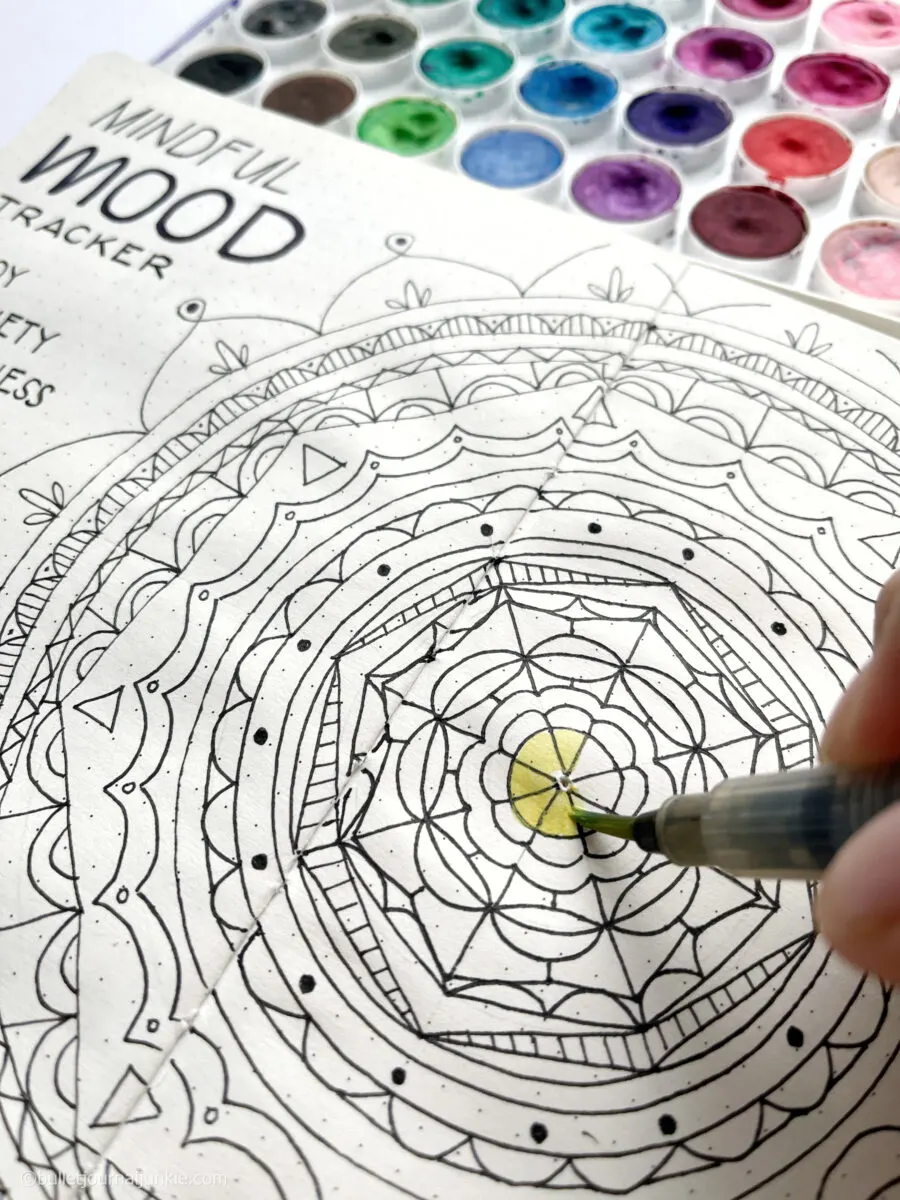Today, I’ll introduce you to a bullet journal layout called Mood Mandala that combines mood tracking with artistic expression and mindfulness. For some bullet journalers, trackers and to-do lists can get too boring to keep our practice fun. Adding an intricately drawn mood tracker can be a solution
In this article, I’ll show you:
- a free printable PDF of my mood mandala layout
- how to record your daily moods using the mandala art
- plus tips on personalizing the experience through design variations
During my slow days, I crave a creative outlet. But when I discovered mood mandala trackers, I started looking forward to a little art session through coloring the intricate circles according to my current feelings. It’s a whole new level of mindfulness journaling.

What A Mood Mandala Layout Is
A mood mandala bullet journal layout offers a creative way to log and track your daily moods using art. It takes inspiration from the mandala, an Eastern mindfulness practice wherein you are encouraged to focus on the intricate geometric patterns. Mandala means “circle” in Sanskrit, hence the circular pattern.
The main feature of a mood mandala is the series of elaborate details like wavy lines, loops, dashes, triangles, and leaf-shaped figures. They are divided into an equal number of rings, which you can give colors based on your current mood.
How The Mood Mandala Layout Tracks Your Moods
A mood mandala layout works by dedicating a series of elaborate “rings” to monitoring your moods for a maximum of 31 days. For the whole month, you’ll be required to log your mood by coloring the ring corresponding to a specific day.
Depending on which colors symbolize your most frequent moods, the resulting image will reveal a colorful tapestry at the end of the month. If your moods had been the same for consecutive days, it will show through shades that almost blur the ring borders. More likely, you’ll see a pattern of colors that show both positive and negative moods.
Based on the appearance of your finished mood mandala, you might decide how to improve or maintain your positive life perspectives. You can even show the finished mood mandala to your therapist or health care provider to advocate for yourself and show how your moods are trending
Download This Free Printable Mood Mandala Layout
If you don’t want to draw a mandala, I recommend that you download this printable PDF of a mood mandala layout so can use it to pattern your next bullet journal spread. Not only will it save you time (this is a complicated design!), but it will also avoid paper wasted in your bullet journal by a poorly inked mistake while learning to make mood mandalas.
Download my Printable Mandala Guide
Begin making mandalas with this printable PDF designed for visual planners:

[purchase_link id=”26022″ text=”Purchase” style=”button” color=”blue”]
Using Colors As Mood “Legends”
The way you use colors to represent your moods in a mood mandala bullet journal layout largely depends on your personal preferences. However, I suggest that you consider first the final image you want to see, and choose colors appropriately.
Here are the colors I used for my own mood mandala:
- Yellow – represents joy
- Blue – represents anxiety
- Pink – represents alertness
- Purple – represents sadness
- Green – represents anger
- Pale Yellow – represents gratitude
- Pale Blue – represents guilt
- Pale Pink – represents awe
How to Use A Mood Mandala Layout in Your Journal
Below is a step-by-step procedure for making a DIY mood mandala layout:
How to Use A Mood Mandala Layout in Your Journal
Total Time 15 minutes
Draw a circle with a Pencil
Use a protractor or a compass to make perfect rings. Starting from as small as 2cm diameter, draw more circles around it, each about 2mm wider than the last. Continue the process until you have 31 rings.
Add intricate details in Pen
Create interesting shapes and lines for the hollow rings. Note that you can get as experimental with the designs as you want. It’s important that 31 rings fit on the page- but it’s not the end of the world if they extend beyond the visible page!
Add more rings with shapes
For outer circles, you may then draw elaborate details like leaf-shaped domes and petals. The length of these details may extend to the edges of your bullet journal spread and beyond.
Add the color legends next to the mood mandala
On the page next to the mandala, identify the colors you’ll be using to represent specific moods. I recommend limiting the number of moods to five, as this will help in finding color patterns once the mandala is completed.
It’s important to include a mixture of positive and negative emotions as well as neutral emotions like contentedness and peacefulness.
Include a label next to the color key indicating the mood in the text. For example, yellow indicates “feeling joyful”. This way, when you finished coloring your mandala, you can refer to the color legends if you forget what they represent.
Color Daily
You can draw a full mandala before a month begins or you can add each ring of the mandala day by day. For bullet journalers who want a longer set-up and quick daily practice, coloring a finished mandala is usually the best choice.
Supply:
- Pen
- Pencil
- Bullet Journal
- Colored Pencils or Markers
Variations for Mood Mandala Bullet Journal Layout
The interesting thing about making a mood mandala layout for your bullet journal is the variety it offers. While I highly recommend drawing one from scratch, there are a few ways to systematically create mandalas for each month. Using a helix ruler, for instance, can give your circles interesting details.
Meanwhile, experimental bujo fans believe that sky’s the limit when it comes to new mandala designs. I’ve even seen some use hearts and stars as replacements for the usual mandala rings.
Others mood mandala bullet journal layouts use round flowers with 31 petals arranged side-by-side. Only the coloring requirement differs from the standard mood mandala layouts because you’ll only need to shade one petal per day. Based on your moods, you can create a mostly single-colored flower or one that has multi-colored petals.
Who Can Use Mood Mandala Layout
Anyone can use a mood mandala layout, although you’ll enjoy this spread most if you’re a creative bullet journaler. It will help release your creative juices- especially if you practice mindful mandala drawing and add an inked layer to the mandala each day. . Visual thinkers may want to try this layout if they find usual trackers boring or inefficient.
Personally, I use the mood mandala to practice focus and to monitor my daily moods. Filling out the hollow rings gives me a sense of calm even when my emotions are raging within me. In fact, historically, mandalas are used for mindfulness. Even psychologist Carl Jung believes that it enhances psychological harmony through physical and mental training 1.
If you’re not fond of elaborate creative practice, this bujo layout may not be suitable for you. It will require a few minutes of your time, which may be too much for a busy journaler racing through a daily bullet journal update.
When a Mood Mandala Layout Might Be Most Helpful
Mood mandala layouts may prove especially useful for people who struggle with getting distracted or have problems with focus. Jung introduced the mandala to Western Psychology and argued that it could help improve focus. If you have difficulties focusing on the present or staying mindful, you may want to try using a mood mandala to train your mind to refocus.

How Often to Use Mood Mandala Layout in a Journal
I suggest that you try out a mood mandala layout once a month to see if it suits your mood tracking needs. If you find this an interesting practice, then by all means repeat the pattern on other bujo spreads so you can compare your mindfulness progress through one month to another.
Final Thoughts on Using Mood Mandala Layout in 2023
With the renewed interest in bohemian-inspired aesthetics, it seems that the mood mandala layout is enjoying its popularity even into 2023. In this article, you have learned how to use a mood mandala layout for tracking your moods, as well as the steps in making one and the design variations you could use.
Image Description for Screen Readers
The image shows a bullet journal notebook with a spread entitled “Mindful Mood Tracker”. On the left side of the notebook vertically lies a watercolor palette in yellow, gold, pink, brown, purple, navy blue, green, dark brown, and black.
On the right page of the notebook is an illustration of a mandala with intricate details. The illustration stretches to half of the left page. The mandala is shaded with a variety of colors.
On the left page is a list of color legends in this order: yellow for joy, blue for anxiety, pink for alertness, purple for sadness, green for anger, pale yellow for gratitude, pale blue for guilt, and pale pink for awe.
Sources
- Liu, C., Chen, H., Liu, C. Y., Lin, R. T., & Chiou, W. K. (2020). Cooperative and individual mandala drawing have different effects on mindfulness, spirituality, and subjective well-being. Frontiers in Psychology, 11, 564430. [↩]
